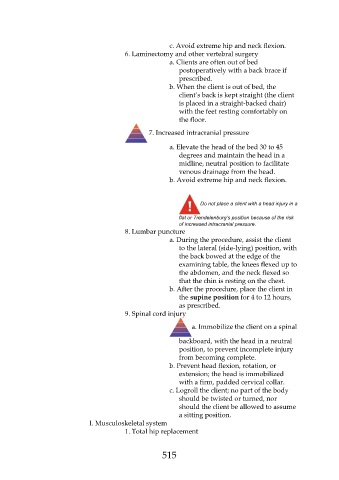Page 515 - Saunders Comprehensive Review For NCLEX-RN
P. 515
c. Avoid extreme hip and neck flexion.
6. Laminectomy and other vertebral surgery
a. Clients are often out of bed
postoperatively with a back brace if
prescribed.
b. When the client is out of bed, the
client’s back is kept straight (the client
is placed in a straight-backed chair)
with the feet resting comfortably on
the floor.
7. Increased intracranial pressure
a. Elevate the head of the bed 30 to 45
degrees and maintain the head in a
midline, neutral position to facilitate
venous drainage from the head.
b. Avoid extreme hip and neck flexion.
Do not place a client with a head injury in a
flat or Trendelenburg’s position because of the risk
of increased intracranial pressure.
8. Lumbar puncture
a. During the procedure, assist the client
to the lateral (side-lying) position, with
the back bowed at the edge of the
examining table, the knees flexed up to
the abdomen, and the neck flexed so
that the chin is resting on the chest.
b. After the procedure, place the client in
the supine position for 4 to 12 hours,
as prescribed.
9. Spinal cord injury
a. Immobilize the client on a spinal
backboard, with the head in a neutral
position, to prevent incomplete injury
from becoming complete.
b. Prevent head flexion, rotation, or
extension; the head is immobilized
with a firm, padded cervical collar.
c. Logroll the client; no part of the body
should be twisted or turned, nor
should the client be allowed to assume
a sitting position.
I. Musculoskeletal system
1. Total hip replacement
515

